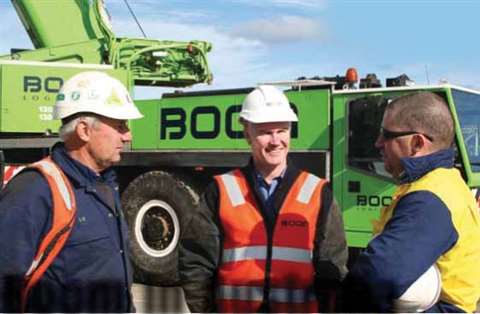Boom in Australia
11 April 2008

IC: What is your industry background? ML: I have been with Boom Logistics for five years and been responsible for the listing of the company in October 2003. Prior to that I was employed by Bovis Lend Lease and exposed to a range of non-residential and residential construction activities.
What plans do you have to develop the company? The company has many avenues for growth and development. The outlook for the business is strong and there are many market opportunities in the crane industry and the broader hire industry. Beyond that we have the opportunity to provide a more comprehensive sales and after sales service to owners of crane fleets via James Equipment.
In what direction is the Australian rental sector heading? The rental sector will continue to consolidate and operate in tiered levels. There will be the level that continues to meet the needs of corporate Australia and then there will be the smaller fragment tier that will continue to service SMEs.
Where do you see the industry in 10 years? I think the business is becoming increasingly global and so I would not be surprised to see multi-national ownership of rental businesses around the globe.
Earlier this year Boom Logistics revised its profit expectations down by 11% for the fiscal year ending 30 June 2007. It followed high winds along the east coast where the company does much of its work. Is this the first time extreme weather conditions caused these problems for the Australian industry? In February the business endured cyclone activity in Northern Queensland followed by extreme flooding conditions. In March three cyclones affected Northern WA [Western Australia], which, again, caused disruption to our services. Finally, in June, we saw 50 year flooding throughout the Hunter Valley and the Newcastle regions. These events caused disruption and deferral of planned maintenance activities and customers tried to recover lost output. Over the past five years we have been in pretty much ideal conditions for lifting services and so not experienced the magnitude of these weather events.
During this period the business was also hampered by delays in the delivery of new equipment due to worldwide shortages. Do you think the delay in equipment deliveries will have the same negative effect worldwide? In speaking with equipment manufacturers I am told that, historically, while some economies have been enjoying strong growth others have experienced subdued or moderate growth. Presently, most economies are strong and so we are seeing supply shortages and extended lead times in obtaining equipment. That said, manufacturers are recognizing the need to expand capacity to address these supply shortages.
Is the industry safe and is it doing enough to ensure safety? Safety is a fundamental part of our business. I think the industry as a whole has a way to go and I would like to think that we lead the way through our safety infrastructure and training commitment.
What disappoints you most about the industry today? I think that there needs to be more uniformity in regulations across the different states of Australia. [But] I think the lifting services industry is a very satisfying industry and I see a progression in service levels being offered to end users.




